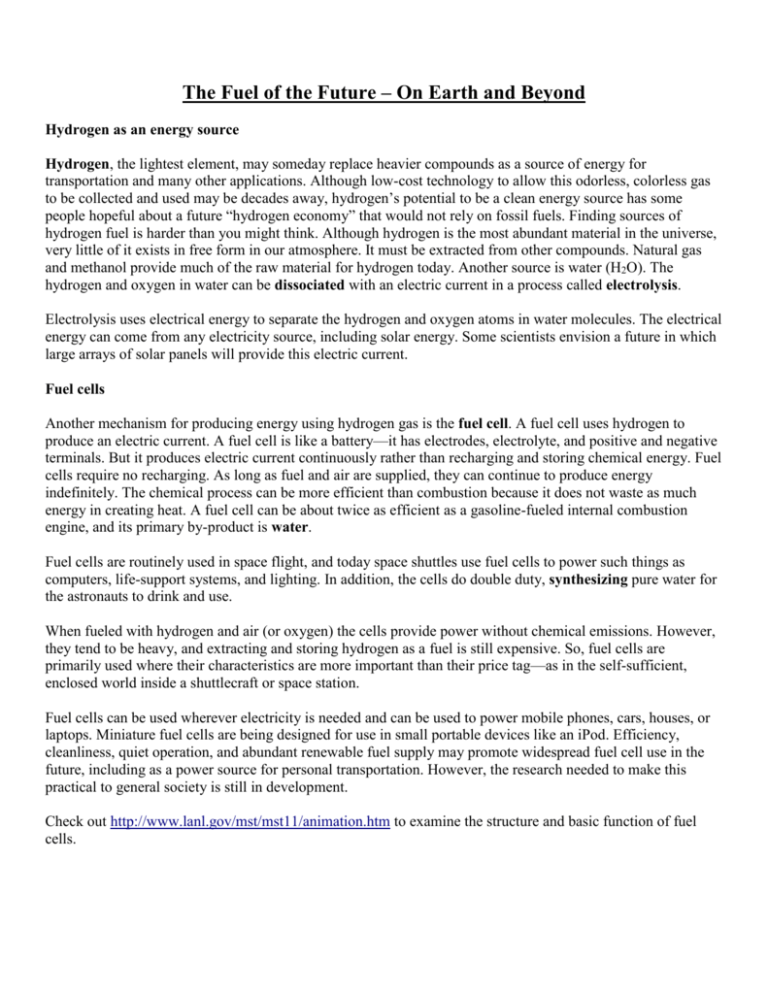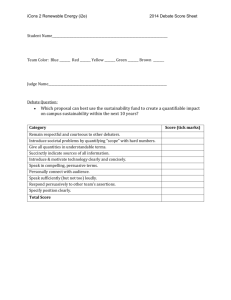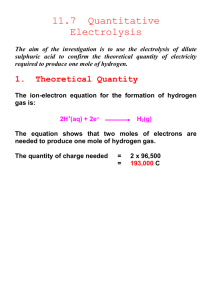link to Fuel of the Future Investigation
advertisement

The Fuel of the Future – On Earth and Beyond Hydrogen as an energy source Hydrogen, the lightest element, may someday replace heavier compounds as a source of energy for transportation and many other applications. Although low-cost technology to allow this odorless, colorless gas to be collected and used may be decades away, hydrogen’s potential to be a clean energy source has some people hopeful about a future “hydrogen economy” that would not rely on fossil fuels. Finding sources of hydrogen fuel is harder than you might think. Although hydrogen is the most abundant material in the universe, very little of it exists in free form in our atmosphere. It must be extracted from other compounds. Natural gas and methanol provide much of the raw material for hydrogen today. Another source is water (H2O). The hydrogen and oxygen in water can be dissociated with an electric current in a process called electrolysis. Making’ Hydrogen Electrolysis uses electrical energy to separate the hydrogen and oxygen atoms in water molecules. The electrical energy can come from any electricity source, including solar energy. Some scientists envision a future in which large arrays of solar panels will provide this electric current. Fuel cells Another mechanism for producing energy using hydrogen gas is the fuel cell. A fuel cell uses hydrogen to produce an electric current. A fuel cell is like a battery—it has electrodes, electrolyte, and positive and negative terminals. But it produces electric current continuously rather than recharging and storing chemical energy. Fuel cells require no recharging. As long as fuel and air are supplied, they can continue to produce energy indefinitely. The chemical process can be more efficient than combustion because it does not waste as much energy in creating heat. A fuel cell can be about twice as efficient as a gasoline-fueled internal combustion engine, and its primary by-product is water. Fuel cells are routinely used in space flight, and today space shuttles use fuel cells to power such things as computers, life-support systems, and lighting. In addition, the cells do double duty, synthesizing pure water for the astronauts to drink and use. When fueled with hydrogen and air (or oxygen) the cells provide power without chemical emissions. However, they tend to be heavy, and extracting and storing hydrogen as a fuel is still expensive. So, fuel cells are primarily used where their characteristics are more important than their price tag—as in the self-sufficient, enclosed world inside a shuttlecraft or space station. Fuel cells can be used wherever electricity is needed and can be used to power mobile phones, cars, houses, or laptops. Miniature fuel cells are being designed for use in small portable devices like an iPod. Efficiency, cleanliness, quiet operation, and abundant renewable fuel supply may promote widespread fuel cell use in the future, including as a power source for personal transportation. However, the research needed to make this practical to general society is still in development. Check out http://www.lanl.gov/mst/mst11/animation.htm to examine the structure and basic function of fuel cells. The Fuel of the Future – On Earth and Beyond Electrolysis – Background An electrode is a conductor in a circuit that carries electrons to or from a substance. The negative electrode, at which electrons are produced, is called the anode. The electrode at which electrons are consumed is the cathode and is labeled as the positive electrode. Electrolysis can be used to demonstrate the opposite process to that occurring in a battery: how electrical energy can be converted to chemical energy. Electrolysis means passing an electric current through a solution to cause chemical decomposition. The container in which electrolysis is carried out is called an electrolytic cell. An electric current passing through an electrolytic cell can trigger chemical reactions that heat alone cannot initiate. Electrolysis only occurs when enough electrically charged ions are present in an electrolyte to carry an electric current. Distilled water does not conduct electric current, because distilled water contains no ions of dissolved salts or minerals. However, the presence of a small amount of an electrolyte, such as sodium chloride, allows water to conduct electricity. Under these conditions, water (H2O) can be separated into hydrogen and oxygen. Electrons flow from the anode to the cathode. When a current is passed through a salt-water electrolyte, positively charged hydrogen ions (H+) are drawn to the anode. At the anode they gain an electron and become hydrogen atoms (H). Pairs of hydrogen atoms then combine to form molecules of hydrogen gas (H2), which bubbles up from the anode. Similarly, oxygen gas (O2) is produced at the cathode side of the electrolytic cell by a process involving the loss of electrons. Part A: Initial Investigation Introduction: This activity is designed for you to investigate a method to produce oxygen and hydrogen from water. The insight gained from this investigation should help you address some of the challenges you might face when planning your space mission. In particular, the generation of oxygen for human respiration and hydrogen as a potential fuel source in fuel cells. Problem: Does the electrolysis of water produce greater quantities of oxygen or of hydrogen? Hypothesis: Write a statement that answers the problem. Materials goggles or eye protection DC power source two electrical wires two test tubes water 250 ml beaker 150 ml distilled water 5 grams of sodium sulphate wooden splints stopwatch Procedure 1. 2. 3. 4. Put on your eye protection. Fill a 250 ml beaker with distilled water to within 3 cm from the top. Add 5 g of sodium sulphate to the beaker and set aside the remaining 10 grams. Assemble the electrolytic cell as demonstrated by your teacher. It should resemble the apparatus shown in Figure 2 on page 52 of your textbook. Be sure that the switch of the power source is in the off position. Set the voltage dial to the maximum. 5. Have your teacher check your assembly before proceeding. 6. Turn on the switch and record your qualitative observations. Turn off the switch after 10 minutes have elapsed. 7. Compare the quantities of gases produced in each cylinder Analysis 1. What is the identity of the gases in each test tube? Explain. 2. Can you think of a possible explanation for the differences in the volumes produced? Conclusion: Write a concluding statement for this investigation. Be sure to address the problem and your hypothesis. Part B: Exploring Electrolysis – Design your own investigations Based on your initial investigation and using the Scientific Inquiry (pgs. 526-527) section of the Skills Handbook design an experiment to test ONE of the following questions: Problem 2: What effect does increasing the circuit voltage have on the rate of gas production? Problem 3: What effect does increasing the concentration of the electrolyte have on the rate of gas production? Problem 4: Which electrolyte, potassium iodide or sodium sulfate, is most suitable for the production of oxygen and hydrogen gas? You must write a hypothesis, a step by step procedure and create data tables for recording your observations before conducting the investigation. Communicating your results Using the Communicating (pgs. 564-565) section of your textbook as a guide write a formal, typewritten report which includes the following sections: a. b. c. d. e. f. g. h. i. j. Cover page Title Introduction Problems you investigated Hypothesis Materials Diagram of the apparatus Numbered procedure Qualitative Observations – Data tables Conclusion You should write one lab report that presents the findings of all the questions that you investigated. Check the rubric for specific expectations for each section of the report.






